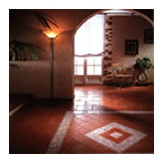How to Install Tiled Shower Kits
Everything you need to know to install our Pro Advanced shower kits!
Tools and Materials Required
- Jigsaw (for subfloor drain hole) & Drill (for pilot hole)
- Premium Modified (Latex/Polymer) Thin-set Mortar (no premixed) -- we recommend Tec mortars
- 5-Gallon Bucket
- Mixer, caulking gun
- 1/4" x 3/8" up to 1/4" x 1/4" square or V-notch trowel
- Margin Trowel
- Utility Knife
- PVC or ABS Cement, and section of coupler pipe for connection
- Level
- Acetone (less than a pint) - consider your ventilation
- ProAdvanced Complete Shower Installation Kit:
- Shower pan (with extension sets for larger sizes)
- 108 - 216 square feet of waterproofing membrane
- 33 - 66 linear feet of waterproof joint band
- 4 pre-shaped inside corners
- 1 drain flange with ABS or PVC neck (check your local standards for using ABS or PVC)
- 1 tube waterproofing sealant (NobleSeal)
- Drain grate riser with construction plug and hair trap
- Drain grate
- (Optional) Curb pieces
- (Optional) 2 outside corners for the curb
Additional Considerations
- Choosing the highest quality premium modified (latex/polymer) thinset you can find will make your installation much easier and yield better results. After decades of using every brand available, we highly recommend TEC brand adhesives.
- Despite what some other companies claim, modified thinset is recommended by the Tile Council of America (TCA) regarding tile standards and provides modern standards of performance. However, you may at your discretion use an unmodified thinset if you have good reason to do so and/or are very experienced with maximizing results with such material; it does cure faster. Maximizing air flow in the work area will really help accelerate cure times of your thinset.
- If you are installing very large, heavy tiles on your walls (12 x 18, 12 x 24), we highly recommend TEC 3N1 Lightweight Performance Latex Modified Mortar - the 30 lb bag yields the same coverage as a 50 lb bag of standard-style mortar. No other mortar compares to the non-slump holding power of this mortar.
- Rather than sealing and resealing and scrubbing grout, we recommend the use of a grout ad mix. For damp areas, a great choice is the Tile Doctor Ad Grout Mix with Shield technology. In addition to sealing performance, this mix forms a permanent, no-VOC defense against mold, mildew or any other growth. If you are after the best product for stain resistance, use TEC Grout Boost Pro which now has mold and mildew protection. Both products are available in a 70 oz. liquid designed to treat exactly 25 lbs of dry grout (use instead of water - but may add extra water to achieve desired consistency.)
Installation Videos
The following videos provide an excellent general guideline for installation. The left video shows the general installation techniques for installing a 32 x 60 kit; the video example shows an offset drain installation, but the principles are identical for a center drain. The right video shows general installation tips for installing optional curbs. You may build your own curbs and follow the same general guidelines for waterproofing as shown in the video. Some actual steps may vary or additional steps may be required depending on your specific kit.
Easy Install Step By Step Instructions
Click here to download the following instructions in PDF form
Before you begin - Ensure that your subfloor is flat and level. If not, use leveling compound.
 Step 1 - Locate drain position and arrange pan pieces to center over drain area. If the area is smaller than the pan or pan plus extension(s), trim foam with a fine-toothed hand or power saw - preferably equally from each side - until the pan pieces fit the custom space properly. If the overall pan size is smaller than the desired floor plan, dry-pack mortar may be used to extend the size of the shower pan where needed.
Step 1 - Locate drain position and arrange pan pieces to center over drain area. If the area is smaller than the pan or pan plus extension(s), trim foam with a fine-toothed hand or power saw - preferably equally from each side - until the pan pieces fit the custom space properly. If the overall pan size is smaller than the desired floor plan, dry-pack mortar may be used to extend the size of the shower pan where needed.
 Step 2 - Mark general drain location on the subfloor (if it does not already exist) by using the center hole of the dry-fitted pan pieces as a guide. If kit does not include an extra template, trace another circle 1/2" inside the existing circle.
Step 2 - Mark general drain location on the subfloor (if it does not already exist) by using the center hole of the dry-fitted pan pieces as a guide. If kit does not include an extra template, trace another circle 1/2" inside the existing circle.
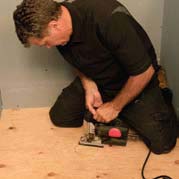 Step 3 - Drill pilot hole on the inner circle you have hand drawn or drawn from template. Use the jigsaw to cut hole in subfloor.
Step 3 - Drill pilot hole on the inner circle you have hand drawn or drawn from template. Use the jigsaw to cut hole in subfloor.
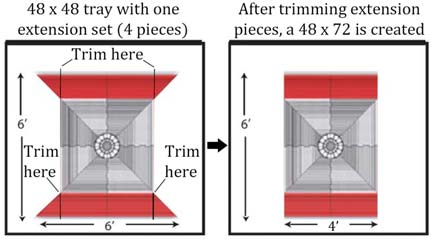 Step 4 - Dry fit and trim drain flange and pan pieces. A 48x48 pan will include 4 interlocking pieces. A 32x60 pan will have two. A 72x72 kit consists of a 48x48 pan with 2 extension sets (a total of 8 additional panel pieces.) The 48x72 kit uses just one extension set with the four extension pieces laid out as per the diagram then trimmed.
Step 4 - Dry fit and trim drain flange and pan pieces. A 48x48 pan will include 4 interlocking pieces. A 32x60 pan will have two. A 72x72 kit consists of a 48x48 pan with 2 extension sets (a total of 8 additional panel pieces.) The 48x72 kit uses just one extension set with the four extension pieces laid out as per the diagram then trimmed.
 Step 5 - Your drain pan is usually precut for this custom drain flange. However if it is not, trim the inside of the pan drain opening to allow for a snug fit of the flange. It should fit as seen in the picture (this example shown in a 32x60 pan).
Step 5 - Your drain pan is usually precut for this custom drain flange. However if it is not, trim the inside of the pan drain opening to allow for a snug fit of the flange. It should fit as seen in the picture (this example shown in a 32x60 pan).
 Step 6 - Test Fit drain flange in pan and measure distance to 2" waste pipe fitting under subfloor. Cut and test the proper length coupler pipe that will attach flange to waste pipe but still properly seat flange into pan/floor assembly. Ensure that this is correct - your next step will be to glue the flange to the waste pipe plumbing.
Step 6 - Test Fit drain flange in pan and measure distance to 2" waste pipe fitting under subfloor. Cut and test the proper length coupler pipe that will attach flange to waste pipe but still properly seat flange into pan/floor assembly. Ensure that this is correct - your next step will be to glue the flange to the waste pipe plumbing.
Step 7 - Trowel thinset onto the entire subfloor in the pan area using a 1/4" x 3/8" up to a 3/8" x 3/8" trowel. Press the first pan section firmly into the thinset, then peel back to check coverage. If 100% coverage is not achieved, back-butter the bottom of the pan piece with additional thinset and repeat until 100% coverage is achieved. Repeat until all sections are installed into the desired pan area. Walk over the pan sections to help ensure that each piece is fully embedded into the thinset mortar.
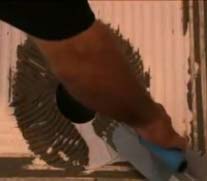 Step 8 - Trowel premium modified thinset mortar into the drain flange recess of the pan as shown. This pan was designed to fit several different types of drain flanges. For the Advanced Custom kit, there will be an outer ring recess area outside of the drain flange that will need to be completely filled with thinset before applying membrane.
Step 8 - Trowel premium modified thinset mortar into the drain flange recess of the pan as shown. This pan was designed to fit several different types of drain flanges. For the Advanced Custom kit, there will be an outer ring recess area outside of the drain flange that will need to be completely filled with thinset before applying membrane.
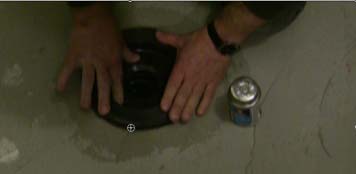 Step 9 - Depending on your plumbing, begin to apply appropriate PVC or ABS glue to your waste pipe, your precut coupler pipe (from step 5) and the inside of the drain flange output neck. (If you somehow have the wrong type flange for your plumbing - ABS black, PVC white/gray - you may use a universal glue. Check you area for code requirements.) To prevent glue from setting up too fast, you may want to bond one piece at a time - i.e. coupler pipe to waste pipe, then flange to coupler pipe. Seat the drain flange down onto the coupler pipe until firmly embedded into the troweled thinset. Photos show seating into a mortar bed installation rather than a pan - the concept is the same.
Step 9 - Depending on your plumbing, begin to apply appropriate PVC or ABS glue to your waste pipe, your precut coupler pipe (from step 5) and the inside of the drain flange output neck. (If you somehow have the wrong type flange for your plumbing - ABS black, PVC white/gray - you may use a universal glue. Check you area for code requirements.) To prevent glue from setting up too fast, you may want to bond one piece at a time - i.e. coupler pipe to waste pipe, then flange to coupler pipe. Seat the drain flange down onto the coupler pipe until firmly embedded into the troweled thinset. Photos show seating into a mortar bed installation rather than a pan - the concept is the same.
Step 10 - Your waterproofing membrane is 1 meter or 39.5" wide. On 32" wide shower kits, you can precut a single sheet of membrane and precut for the drain hole if desired. On all other shower kit configurations or on larger mortar bed layouts, you will need to plan for at least two sheets with a minimum of a 2" overlap. Ensure that the two pieces DO NOT overlap at the drain location to help ensure installation integrity. With a single piece membrane for a 32 x 60 kit, trowel premium modified thinset over the entire pan area with a 1/4" x 3/16" v-notch up to a 1/4" x 1/4" square trowel. Do not trowel thinset onto the drain flange like a fleece type flange! Because of the single piece membrane, you can simplify the installation by applying 2 to 3 generous beads of NobleSealant 150 waterproofing sealant in the circular rings around the drain opening. The waterproofing sealant retains superior bond and flexibility compared to thinset and will bond tenaciously to both the membrane and the plastic flange. Lay the precut pan piece over the pan area paying careful attention to the alignment of the drain hole over the beads of sealant. Use the flat side of your trowel or a flat trowel to press the membrane into the thinset and to press the membrane into the sealant at the drain flange - excess sealant should press out at the drain opening. During installation, run hands over membrane to ensure that no air bubbles are trapped. Test installation by peeling back membrane to ensure 100% coverage. Keep working in membrane or adding additional thinset if necessary to ensure 100% thinset coverage.
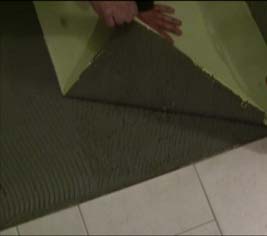 Step 11 - Trowel premium modified thinset mortar onto one side of the pan area with a 1/4" x 3/16" V-notch trowel up to a 1/4" x 1/4" square trowel. You may use the “traditional" 1/8" x 1/8" square trowel but will be adding extra work to ensure 100% thinset coverage of membrane. Take special care not to thinset the drain flange - wipe off any overage. Lay one of your sections into the mortar and press vigorously into the thinset with the flat section of your trowel. Peel back membrane to ensure you have achieve 100% coverage. Keep working and/or add thinset to achieve 100% coverage. During process, run hands over membrane to ensure no air bubbles form. Work out any excess thinset with the flat edge of your trowel if necessary.
Step 11 - Trowel premium modified thinset mortar onto one side of the pan area with a 1/4" x 3/16" V-notch trowel up to a 1/4" x 1/4" square trowel. You may use the “traditional" 1/8" x 1/8" square trowel but will be adding extra work to ensure 100% thinset coverage of membrane. Take special care not to thinset the drain flange - wipe off any overage. Lay one of your sections into the mortar and press vigorously into the thinset with the flat section of your trowel. Peel back membrane to ensure you have achieve 100% coverage. Keep working and/or add thinset to achieve 100% coverage. During process, run hands over membrane to ensure no air bubbles form. Work out any excess thinset with the flat edge of your trowel if necessary.
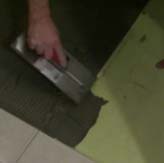 Step 12 - Trowel at least 2" wide path of thinset to prepare for the membrane overlap. Repeat previous process of laying overlapping membrane into thinset and pressing in with flat end of trowel. Many times throughout the entire kit installation, peel back the membrane to ensure you are achieving 100% thinset coverage of the membrane. Finalize the overlap installation in this section of the pan floor by pressing and smoothing the overlapping membrane section at the seam.
Step 12 - Trowel at least 2" wide path of thinset to prepare for the membrane overlap. Repeat previous process of laying overlapping membrane into thinset and pressing in with flat end of trowel. Many times throughout the entire kit installation, peel back the membrane to ensure you are achieving 100% thinset coverage of the membrane. Finalize the overlap installation in this section of the pan floor by pressing and smoothing the overlapping membrane section at the seam.
 Step 13 - Repeat the installation process on the other side of the pan until the entire two sections of membrane are completely overlapped properly and seated into the thinset. The membrane should be stretched taught over the drain flange, so that the outline of the cavity can be seen. With a razor knife, slit the center section within the inside of the cavity in an ‘X’ pattern. Using the NobleSealant 150 waterproofing sealant loaded in a caulking gun, run a least two complete and generous beads of sealant on the ringed section of the flange that surrounds the opening. It can be a bit challenging to see what you are doing during this step, so take your time. Trim away the excess membrane within the center cavity opening.
Step 13 - Repeat the installation process on the other side of the pan until the entire two sections of membrane are completely overlapped properly and seated into the thinset. The membrane should be stretched taught over the drain flange, so that the outline of the cavity can be seen. With a razor knife, slit the center section within the inside of the cavity in an ‘X’ pattern. Using the NobleSealant 150 waterproofing sealant loaded in a caulking gun, run a least two complete and generous beads of sealant on the ringed section of the flange that surrounds the opening. It can be a bit challenging to see what you are doing during this step, so take your time. Trim away the excess membrane within the center cavity opening.
Step 14 - Using a margin trowel or the flat section of your trowel, press the membrane into the sealant area to ensure a complete bond. Sealant should squeeze out into the center cavity area. Scrape off excess. A paper towel comes in handy during this step.
 Step 15 - Trowel thinset into an inside corner to prepare for the pre-shaped inside corner piece. Fit the corner piece into position by hand. Using a margin trowel or the flat section of your trowel, press the corner into the thinset area to ensure a complete bond. Be sure to peel a section back to check for 100% coverage. Smooth the corner out and check for air bubbles. A properly installed corner blends into the installation as shown in the picture. Repeat for all 4 inside corners.
Step 15 - Trowel thinset into an inside corner to prepare for the pre-shaped inside corner piece. Fit the corner piece into position by hand. Using a margin trowel or the flat section of your trowel, press the corner into the thinset area to ensure a complete bond. Be sure to peel a section back to check for 100% coverage. Smooth the corner out and check for air bubbles. A properly installed corner blends into the installation as shown in the picture. Repeat for all 4 inside corners.
 Step 16 - Measure your joint seam band section and cut your 5" or 6" wide band to measurement. Fold strip in half lengthwise and press to crease. Test fit precreased section to ensure proper fit. Trowel thinset onto the section to prepare for the precreased joint band section. Fit the joint band piece into position by hand. Using a margin trowel or the flat section of your trowel, press the section into the thinset area to ensure a complete bond. Be sure to peel a section back to check for 100% coverage. Smooth out and check for air bubbles.
Step 16 - Measure your joint seam band section and cut your 5" or 6" wide band to measurement. Fold strip in half lengthwise and press to crease. Test fit precreased section to ensure proper fit. Trowel thinset onto the section to prepare for the precreased joint band section. Fit the joint band piece into position by hand. Using a margin trowel or the flat section of your trowel, press the section into the thinset area to ensure a complete bond. Be sure to peel a section back to check for 100% coverage. Smooth out and check for air bubbles.
Step 17 - After completing all lower horizontal joint strips, proceed to installing vertical joint strips using the exact same techniques. If you are not taking your tiling all the way up to the ceiling, be sure to mark where your tiling will end and measure the correct length for each piece. Repeat for any vertical corner surfaces. Note: If you run short on band, you can create your own out of any excess membrane.
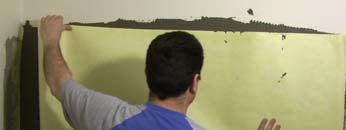 Step 18 - You may wish to wait for the floor to cure a bit before proceeding. In any case, take care when moving over your freshly-installed floor sections. With all joints and corners complete, begin to install the wall pieces starting from the bottom up. Ensure at least a 2" overlap on any adjoining sections. Installation continues exactly like it did for floor sections. As always, peel back membrane to ensure 100% coverage and constantly run hands over membrane to feel for any trapped air bubbles.
Step 18 - You may wish to wait for the floor to cure a bit before proceeding. In any case, take care when moving over your freshly-installed floor sections. With all joints and corners complete, begin to install the wall pieces starting from the bottom up. Ensure at least a 2" overlap on any adjoining sections. Installation continues exactly like it did for floor sections. As always, peel back membrane to ensure 100% coverage and constantly run hands over membrane to feel for any trapped air bubbles.
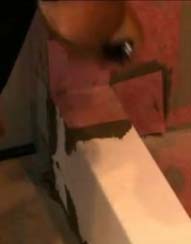 Step 19 - If you have constructed your own curb, ensure that it is sheeted with a rigid material like concrete board or sheetrock. If you purchased the optional curb, test fit your curb sections and trim as necessary to fit the desired space. Trowel thinset into the curb seating area and back-butter the ends, sides and bottom of each curb section. If your curb includes a groove or cavity, be sure to fill it with thinset. The pre-coated curbs from Noble already include plenty of grip and do not require a groove or cavity. Install the curb sections into position. If you purchased a curb, you should have pre-shaped outside corners. Use your corner-installation techniques to install these at each end of the curb. Finally, measure and cut a proper sized piece of membrane to cover the curb. Ensure that there is a minimum of a 2" overlap onto the pan floor. Install like other membrane sections.
Step 19 - If you have constructed your own curb, ensure that it is sheeted with a rigid material like concrete board or sheetrock. If you purchased the optional curb, test fit your curb sections and trim as necessary to fit the desired space. Trowel thinset into the curb seating area and back-butter the ends, sides and bottom of each curb section. If your curb includes a groove or cavity, be sure to fill it with thinset. The pre-coated curbs from Noble already include plenty of grip and do not require a groove or cavity. Install the curb sections into position. If you purchased a curb, you should have pre-shaped outside corners. Use your corner-installation techniques to install these at each end of the curb. Finally, measure and cut a proper sized piece of membrane to cover the curb. Ensure that there is a minimum of a 2" overlap onto the pan floor. Install like other membrane sections.
Step 20 - Allow installation to dry / cure. Although modified thinset provides a superior installation, it does take longer to cure. A box fan in the room circulating air will help speed cure time. You probably will need at least 24 hours for a reasonable cure. You may test an exposed bit of thinset with the point of your razor knife to test cure progress.
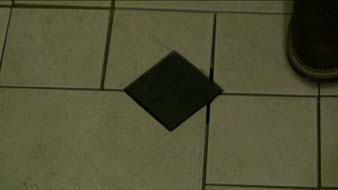 When ready, thread in your drain riser with construction plug. Use spacers to dry fit your floor tile within a groutspace width of the riser's construction plug. During this process, thread your riser so the drain plug is flush with your tile install.
When ready, thread in your drain riser with construction plug. Use spacers to dry fit your floor tile within a groutspace width of the riser's construction plug. During this process, thread your riser so the drain plug is flush with your tile install.
 Step 21 - After setting grate riser position, remove dry-fitted tile from around drain area. Locate the bag of plastic beads included with your kit. Pour these into the four sides of the cavity surrounding the riser. Clean up any scattered beads, smooth out fill and ensure the bead fill is level with the surrounding floor. Because acetone evaporates quickly, ensure the area is well ventilated. Using the included applicator bottle, squirt acetone into the beads which will then instantly “melt" together to form a solid plug. Don’t hesitate to use plenty of acetone - the excess will evaporate. Use margin trowel to press firmly on bead to ensure stability. Gently attempt to twist riser to ensure that it has been fully stabilized. Allow installation to fully cure.
Step 21 - After setting grate riser position, remove dry-fitted tile from around drain area. Locate the bag of plastic beads included with your kit. Pour these into the four sides of the cavity surrounding the riser. Clean up any scattered beads, smooth out fill and ensure the bead fill is level with the surrounding floor. Because acetone evaporates quickly, ensure the area is well ventilated. Using the included applicator bottle, squirt acetone into the beads which will then instantly “melt" together to form a solid plug. Don’t hesitate to use plenty of acetone - the excess will evaporate. Use margin trowel to press firmly on bead to ensure stability. Gently attempt to twist riser to ensure that it has been fully stabilized. Allow installation to fully cure.

